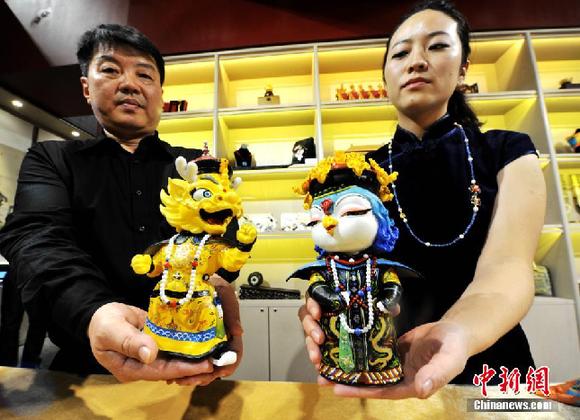Promote Palace Museum with care
- By Xiao Lixin
 0 Comment(s)
0 Comment(s) Print
Print E-mail China Daily, November 26, 2014
E-mail China Daily, November 26, 2014
|
|
|
The Palace Museum mascots named "Zhuangzhuang" and "Meimei" first met the public in Xiamen, Fujian province on Sunday. The mascots' design originates from the Chinese traditional cultural symbols of the dragon and phoenix. [Photo/Chinanews.com] |
The Palace Museum mascots, Zhuangzhuang and Meimei, meaning strong and beautiful in Chinese, were introduced to the public in Xiamen, Fujian province, over the weekend. The dragon and phoenix mascots are traditional Chinese cultural symbols and are expected to boost the museum authorities' efforts to bring the UNESCO World Heritage Site in Beijing closer to the ordinary people.
A new set of creative cultural products introduced by the Palace Museum, with the big hits being beaded earphones and imperial-robe-patterned T-shirts, have become popular on the Internet after the museum opened its official store in 2008 on Taobao, China's leading e-commerce marketplace. Also, a collection of nine flash animations of Qing Dynasty (1644-1911) Emperor Yongzheng (1678-1735) has drawn more than 800,000 clicks since its debut on Aug 1.
The Palace Museum, which people perceive to be a solemn and thus "fun-less" complex, seems determined to change its stereotype public image. It wants to be seen as a place for amusement. Although many have welcomed this transformation, some people, especially netizens, have criticized such blatant "market-oriented moves" to overhaul the serious image of the complex.
Such criticisms are understandable, because the Palace Museum for long symbolized the epitome of imperial power. But even if the site is transformed into a place for amusement, it will not lose its original image, as some people fear. If at all, it will increase its popularity among ordinary people, both at home and abroad, which, in turn, will help popularize Chinese history and culture.
The Palace Museum receives tens of millions of visitors annually, most of whom have hurried through the huge pavilions, gates and exhibition halls, either because of shortage of time or overcrowding and, therefore, failed to have a closer and detailed look at the cultural relics on display.







Go to Forum >>0 Comment(s)